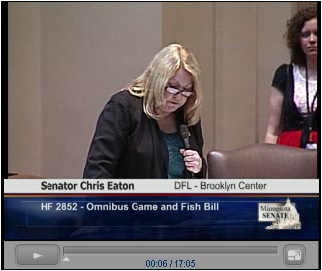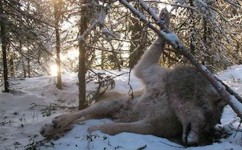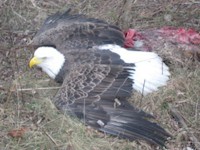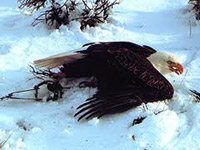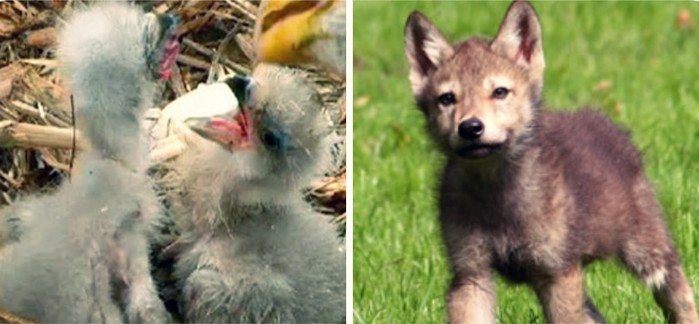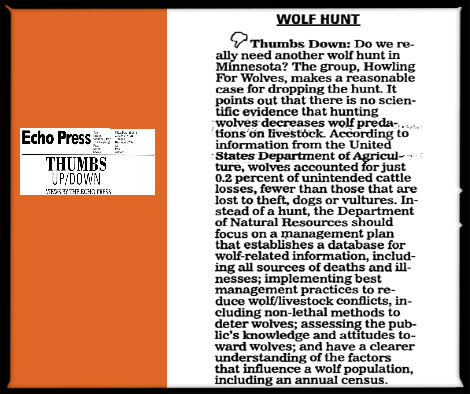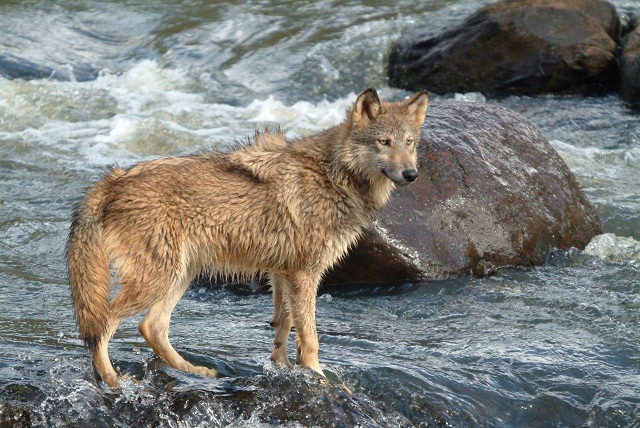Why Gray Wolves Need Continued Federal Protection
You may have heard that wolves were returned to protected status under the Endangered Species Act by a Federal court ruling in December 2014. And while that was great news, it’s not the end of the story.
Sadly, legislation that would reverse that ruling was recently (June 2015) introduced into both Houses of Congress. The language in those bills would delist wolves in the Great Lakes region (which includes Minnesota) and Wyoming from federal protection entirely, leaving them open to state-sanctioned recreational hunts—including inhumane snaring and trapping—and other catastrophic policies. The bills’ language also eliminates any future judicial review, effectively leaving the gray wolf without the possibility of Federal protection, no matter how low their population numbers were to drop.
In essence, it’s a formula for extinction.
Recent history has shown that when Federal protection is removed, it leaves individual states to make policy decisions regarding wolf management. Unfortunately, those decisions are often made hastily, without solid, scientifically-based input or understanding of their possible impacts.
What Happened in Minnesota as an Example
When the gray wolf was first delisted from the endangered species list in 2012, the Minnesota legislature quickly instituted a recreational wolf hunt. It did so in direct opposition to a Minnesota DNR wolf management plan, which has as its goal: "ensuring the long-term survival of the wolf in Minnesota while resolving conflicts between wolves and humans."
The plan mandated a 5-year hunt moratorium when and if delisting of the wolf occurred—a stipulation that was entirely ignored by the Minnesota legislature that authorized the 2012 wolf hunt and trapping seasons.
Wolf Population Impacts
Prior to the 2012 delisting, the Minnesota wolf population had remained stable for over 10 years. The 2012 recreational hunt, however, reduced that self-regulating population by a shocking 25%. The Minnesota DNR reports that 1,650 Minnesota wolves were killed (or found dead) in 2012-2014—years in which “limited hunting seasons” were in effect.
Nationally, the statistics are no better. According to the Center for Biological Diversity, 2,814 wolves were killed between 2011 and 2014 as a result of hunting and trapping that followed delistings.
It’s clear from these statistics that delistings and recreational hunts are not effective ways to ensure the long-term survival of the wolf.
Addressing Wolf-Livestock Conflicts
Reducing predation on livestock and supporting farmers and ranchers are important goals and should be an integral part of responsible wolf management policies. But traditional methods—killing and hunting—have been shown not to work. Alternatively, there are nonlethal methods that do work.
-
Killing Wolves Increases Wolf-Livestock Conflicts: Hunting and indiscriminately killing wolves has been shown to be ineffective in reducing wolf-livestock conflicts. A 2014 study at Washington State University showed that when wolves are killed to protect livestock, more livestock kills occur the following year, not fewer. This occurs because wolf kills cause packs to break up. Once split, smaller and younger packs become competitors for the same territory and limited food supply, forcing more wolves to hunt domestic livestock.
-
Non-Lethal Methods Work: There are a number of nonlethal methods that have proven successful in addressing wolf-livestock conflicts. They include guard animals, fences, lights, and carcass removal, all of which can effectively reduce these conflicts.
-
Wolf-Livestock Conflicts in Perspective: A common myth is that Minnesota wolves kill large numbers of livestock and pets. In actual fact, the incidence of these conflicts is quite low. In 2011, for example, there were 91 verified calves/cattle kills by wolves on Minnesota farms. While regrettable, this represents less than 2 percent of all beef producers in Minnesota’s wolf territory. Over 200 wolves were killed in response.
There Are Better Ways
A petition to the U.S. Fish and Wildlife Service (USFWS), signed by 22 national and regional conservation and animal protection organizations, calls for the gray wolf to be listed nationally as “threatened.” Doing so would have the following benefits:
-
Allow for continued Federal oversight and funding of wolf recovery efforts and encourage development of a national recovery plan for the species.
-
Give the USFWS regulatory flexibility to permit state and local wildlife managers to address specific wolf conflicts. It would keep the issue out of the court system but still provide for a process by which state plans for wolf recovery are monitored.
The USFWS is Adamant: It Wants to Delist Wolves Entirely
Unfortunately, the Fish and Wildlife Service has rejected the petition on the grounds that it did not prove that all wolves in the lower 48 are “one distinct population group, nor that gray wolves "may be likely to become an endangered species within the foreseeable future."
To the first point, Dr. Maureen Hackett of Howling for Wolves responded:
“We think this reasoning is hypocritical in that USFWS has used ‘distinct populations’ definitions to delist wolves and remove protections. The USFWS’ decision all point toward one direction—to remove Federal protections for wolves and to rid themselves of their duties to protect them.”
To the second point, Brett Hartl, the Center for Biological Diversity’s endangered species policy directory stated:
“This decision makes no sense because wolves in the lower 48 have been protected as an endangered species since 1978. Our petition simply asked the Fish and Wildlife Service to consider downlisting this already recognized population of wolves to threatened.”
There is Hope
Howling for Wolves continues to work to keep wolves protected with actions in Washington and locally. We’re supported by two Federal lawmakers who’ve committed to working on behalf of the wolf. Congresswoman Betty McCollum (D-MN) and Senator Gary Peters (D-MI) understand that wolves need protection and that states need better wolf management policies. Thank you Congresswoman McCollum and Senator Peters!
Federal Protection for Wolves is Essential to Their Survival
History has shown that when Federal protection is removed, states take over the “management” of wolf populations, typically with little or no science-based policies in place. This has endangered the wolf species as a whole and done nothing to resolve wolf-livestock conflicts—in fact, likely increased them.
First and foremost, it should be good science that guides species protection policies and Federal protection is necessary to ensure that science-based strategies are in place and enforced. And because the wolf population ranges across many states, those policies should be consistent throughout wolf territory. This will be the only way to truly ensure “the long-term survival of the wolf” not just in Minnesota, but nationally, as well.
You Can Help Save the Gray Wolf
Our advocates in Congress, Senator Peters and Congresswoman McCollum, have emphasized how essential it is that we call and write our lawmakers to let them know we support Federal protection of the gray wolf. The more lawmakers that hear from their constituents, the more Congresswoman McCollum and Senator Peters can gain their voting support.
Find your representative here.
You can also reach out to thank Congresswoman McCollum and Senator Peters for their support.

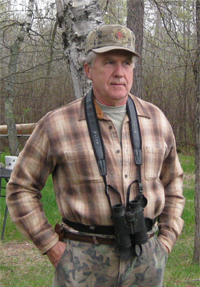 In northern Minnesota we have a 2 week firearms deer season. This 2014 season was from November 8th to sundown on the 23rd. Several events this year are note worthy enough to cite here.
In northern Minnesota we have a 2 week firearms deer season. This 2014 season was from November 8th to sundown on the 23rd. Several events this year are note worthy enough to cite here.

